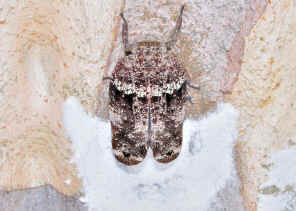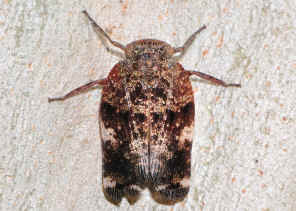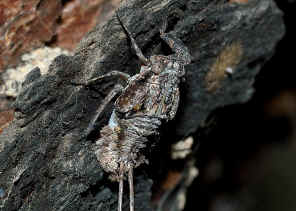|
| |
Family Eurybrachyidae
- This page contains pictures and information about Large Board-frons Planthoppers
in Tribe Platybrachini that we found in the Brisbane area,
Queensland, Australia.
-
 - Newly hatched instars
-
- The Australian Eurybrachyidae are quite
distinctive from the world fauna. All Australian species belong to the
subfamily Platybrachyinae, most are in this tribe Platybrachyini and a few in
tribe Dardini.
-
- Members in this tribe are medium in size with broad body. They have mottled
brown forewings and coloured abdomen, usually brown, red, yellow or orange in colour.
All of them have broad frons (front part of head).
-
- Planthoppers in this tribe are usually
dimorphous, male and female looked different.
-
- They can be found resting on tree trunk of host plants, usually Eucalyptus or
Acacia. They are not noticeable because of their camouflaged
colours. When we come close to them, they will walk to other spots, either up,
down or sideway, and stop moving. If we come even closer and try to touch them, they will jump with a 'tick' sound and fly away.
-
- Females usually lay eggs on tree trunks. The eggs are covered with a
white waxy secretion produced by the ovipositing female. Nymphs are
usually brown to dark brown in colour. Nymphs habit are about the same as the
adults. Like other members in the Hemiptera order,
Planthoppers have their sucking mouth-parts to feed on host plants by sucking
up the sap.
-
- We summarized the general information of Board-frons Planthoppers in this Biology page.
-
Genus Chewobrachys - Wattle Hoppers
- Chewobrachys is the new genus of family Eurybrachyidae. This genus
include two species, the C. sanguiflua and C. limbourgi. The Platybrachys
insignis is a synonym of C. sanguiflua. They are found
in Eastern Australian. The C. sanguiflua species can be found in
Brisbane on Acacia.
-
- Green Red Wattle Hopper
 
 - Female
Male
Nymph
- Chewobrachys sanguiflua (former Platybrachys sanguiflua), body length 15mm
- The Green Red Wattle Hoppers are usually found resting on large wattle (Acacia)
tree trunk. Wings and head resemble the colour and texture of
the tree barks. It abdomen is bright-red in colour and the face is green. The genus name of the
species, Chewobrachys, is the same as our surname Chew!!
Check this page
to find out why.
-
Genus Hackerobrachys - Wattle Hoppers
- Green Face Wattle Hopper

  - Female
Male
Nymph
- Hackerobrachys viridiventris, (former Olonia viridiventris), body length adult 11mm, nymph 7mm
- Green Face Wattle Hoppers were found on wattle and have a bright yellow-green frons and
pale green abdomen. More pictures and information please click on here.
-
- We found quite a number of different Platybrachys
Genus in Brisbane. They are usually found on the main trunk of trees of the Eucalyptus. They are
usually found resting or walking up and down or
sideways around the tree trunks. The nymphs can also be found on the same
tree.
-
- Jerôme Constant suggested that the species in this Platybrachys genus represent a number of different genera. Once he has completed his revision, the
genus Platybrachys will be more strictly defined and several new genera will
be created.
-
- Teeth-marked Gum Hopper


 - Female
Male
Nymph
- Platybrachys barbata, adult body length 20mm, nymph body
length 10mm
- The adult and nymph pictures are taken on the same gum tree trunk early summer. This species is somewhat variable in colour. Females
are paler in colour with the "teeth pattern band" across middle of
forewings. This pattern make the planthopper looks like a width-opened
vertebrate mouth when watching from behind. Please
click here for more pictures and information.
-
-
- Green Face Gum Hopper


 - Female
Male
Nymph
- Platybrachys decemmacula, body length 20mm
- This Green Face Gum Hopper can be found on gum tree truck, leaf and stem. They are common in the
Eucalyptus forest in Brisbane. Their broad frons (front part of head) is
pale to bright green in colour. More pictures and information can be found in here.
-
-
- White-marked Gum Hopper
 
 - Female
Male
Nymph
- Platybrachys leucostigma, body length 20mm
- This Gum Hopper is brown in colour with white cloud patterns on wings. Its head and legs are all brown in colour. We usually found this planthopper
resting on smooth bark gum or gray gum tree trunk. More pictures and
information can be found on this page.
-
-
- Ripple-marked Gum Hopper
  - Platybrachys signata, body length 20mm
- The patterns on the wings of all individuals in this species were
different, although all the had the dark brawn face. The about pictures were
taken in Karawatha Forest on June 2007. Please click on here
for more information.
-
-
- Eye-patterned
Gum Hopper

  - Platybrachys vidua, body length 15mm
- This planthopper rests on tree trunk heading downwards. When moves, it
moves backwards. Together with the eye-patterns on it forewing tips, it gives
the impression of its tail is its head. It looked lager. More information and pictures can
be found in this page.
- Reference:
- 1. Insects
of Australia, CSIRO, Division of Entomology, Melbourne University
Press, 2nd Edition 1991, pp 479.
- 2. Family Eurybrachyidae
- Fletcher, M.J. and Larivière, M.-C. (2009 and updates).
- 3. Genus
Platybrachys Stål sensu lato - By Murray J. Fletcher, 08 April 2007.
- 4. Species
of Eurybrachidae known to occur in Australia - By Murray J. Fletcher,
2009.
- 5. Checklist for Platybrachyini Schmidt, 1908 - Australian Faunal Directory, Australian Biological Resources Study, 2008.
- 6. Northern
Territory Insects, A Comprehensive Guide CD - Graham Brown, 2009.
- Back to Top
[ Up ] [ Eurybrachyid Planthopper Biology ] [ Platybrachini ] [ Dardini ] [ Unknown Eurybrachyid ]
| |
|





















